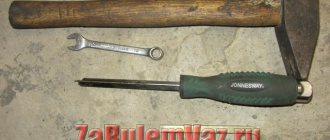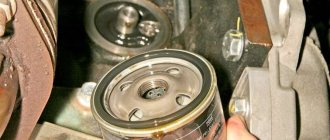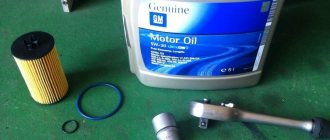Installing the engine in a VAZ 21099 car
VAZ 21099 cars are equipped with four-cylinder, four-stroke carburetor engines with the cylinders arranged in a row, and a camshaft is installed on the head. In the engine compartment of a front-wheel drive car, the engine is located transversely. To increase the durability of engine parts, and therefore the service life of the vehicle, periodic replacement of the engine oil in the VAZ 21099 is necessary. Factors influencing this process may be:
- Duration of use of the car.
- Operating mode.
- Serviceability of motor parts.
- Time of year of car movement.
- Engine oil quality.
- What quality of fuel is used.
After purchasing a car that has recently rolled off the manufacturer's assembly line, changing the VAZ 21099 engine oil (see How to change engine oil) is carried out in strict compliance with the manufacturer's recommendations. This is described in detail in the instructions supplied with the car. Purchasing a used model requires, regardless of the owner’s assurances of cleanliness and a recent fluid change, an oil change. This is done after draining it into a container, washing the device with a special liquid or composition that is subsequently poured into the engine, and installing a new oil filter.
Replacement steps
The algorithm of actions that I propose has already been tested and is the best option. It consists of the following steps:
- At the first stage, we drive the car into an inspection hole or overpass, as in my case.
- Allow the engine to cool so that the oil drains into the engine sump. And later, when you open the drain plug, all the oil drains out. Be careful, draining hot oil can cause severe burns.
- After the engine has cooled, unscrew the oil filter, which is located on the side of the crankcase. It should unscrew without much effort, but there are times when it is difficult to unscrew. For such cases, there is one correct option. Take a long screwdriver and pierce the filter right through. (Be careful not to let any remaining oil in the filter leak onto you). We get a lever with which it will be more convenient to unscrew the filter.
- After unscrewing the filter, we proceed directly to draining the oil. To do this, remove the filler cap on the engine. Then unscrew the drain plug on the pan. To do this, we need a 13mm wrench. Take care in advance of the container into which the used oil will be drained. Wait 7-10 minutes until the oil is completely drained.
- After the oil has completely drained, you need to tighten the drain plug. When tightening the plug, do not overdo it with force (you can break the thread).
- The next step is to install a new oil filter. Before installation, lightly lubricate the filter gasket with used oil. Screw in the new filter until it stops and then tighten it, but not too much.
- After installing the filter, pour new oil into the filler neck. A VAZ 21099 car is usually filled with 3-3.5 liters. But it’s worth buying a 4-liter canister for possible topping up during operation. Fill the oil in parts, checking the oil level with a dipstick. The oil level should be slightly above the halfway point between the minimum and maximum values.
- After you have filled in the oil and checked its level, you need to tighten the filler plug.
- Next, we need to start the engine and look at the pan and filter for leaks. Please note that when starting the engine, the oil pressure indicator will light for 2-3 seconds, after which it should go out.
If there are no leaks and the light on the instrument panel goes out, then the oil change job can be considered complete. After changing the oil in my car, the engine began to run much better and quieter.
What kind of oil should I use and how much?
Owners of the VAZ 21099 (and its modifications with 1.3 and 1.5 liter engines) often fill in semi-synthetic oils with a viscosity of 10W-40. A smaller part (but still there is one) prefer to use synthetics with a 5W-40 class.
The manufacturer recommends maintenance every 15,000 km. In practice, owners try to change the engine oil at 8-10 thousand. If you choose something in between these numbers, then it will be the “Golden Mean”, but of course everyone decides for themselves.
When purchasing, be guided by a filling volume of 4 liters, because... the engine consumes a little more than 3 liters at a time. Do not forget to leave at least 0.5 liters for daily monitoring and, if necessary, topping up the level in the engine.
The choice of a particular company is not important; for “Ninety-Ninth” you can buy both oils from the middle and low price ranges. Here are some of the many products on sale today.
- G-energy 10w40;
- Totachi Touring 5w40;
- Sibi MOTOR 5W40;
- Motul 5W40 300V;
- Eni i-sint 10w40 and many others.
Along with the fluid, the oil filter also needs to be changed. Today, many manufacturers are available for sale at low prices.
- 0 451 103 274 BOSCH ~$4;
- 2108-1012005 AG Auto Parts ~ $1.5;
- 2108-1012005 WIX ~ 2.5$;
- MANN W914/2 ~ 5$;
... and a large number of other filters that can be found on the Internet today.
A little about oil
Before you begin the replacement procedure, you need to find out what and in what quantity should be filled.
In VAZ 2109 cars, usually 3 to 3.5 liters of lubricant are poured into the engine. At the same time, it is recommended to purchase a 4-liter container, so that as you use it you have the opportunity to top up the lubricant used.
Periodically check with a dipstick what level the lubricant is. Optimally, a trace of oil remains on the dipstick between the maximum and minimum marks. Golden mean. It’s not worth filling above the maximum mark, just like driving with underfilled lubricant.
We have decided on the volume of oil. What exactly should it be?
If we take into account the issue of quality, the optimal solution for the VAZ 2109 would be a synthetic lubricant. But it is the most expensive. Semi-synthetics are more affordable, but the quality characteristics are lower. If finances do not allow it at all, you can get by with mineral oil. But it’s better not to skimp on this issue.
Another point is that if you have an engine with a fairly high mileage, then it is best to use semi-synthetic oil.
Do not mix different brands of oil under any circumstances, and when replacing, first flush the system with a flushing compound, and then fill in new fluid.
1.l, 81 hp, gasoline, front-wheel drive/all-wheel drive (4WD), manual transmission, 1994 - 2004
- Trims: 1.6i MT Base, 1.6i MT Victory
- Engine: VAZ-210994
| Engine oil volume | SAE classification | Replacement interval | Engine oil |
| 3.5 l * | — | 10000 km / 12 months** | — |
Additional Information
- Oil type: synthetic
* — service oil volume is indicated.
** - when operating a vehicle in difficult conditions (high load, harsh environmental conditions, low quality fuel, city traffic jams and short trips), it is recommended to reduce the engine oil change interval by 2 times.
Found an error in your data? Please let us know about it.
see also
TOP 5 motor oils according to PartReview users
- 43 5 62k
Gasoline in engine oil
- 5 1 6k
Which oil filter is better
- 51 24 83k
Where is the oil pressure sensor
- 8 0 14k
Which flushing oil to choose
- 8 0 5k
Calculator for converting liters of engine oil to kg
Converting engine oil from liters to kilograms.
Online calculator The production of the VAZ 21099 “Sputnik” was launched at the AvtoVAZ plant in 1990. The car differed favorably from its predecessor VAZ 2109 with its four-door Sedan body, the installation of a five-speed gearbox and the upgraded VAZ-210993 (1.3 l) and VAZ-210990 (1.5 l) engines installed on it. For those interested in the topic of maintenance, in this photo report we will clearly demonstrate how the procedure for changing the oil on a VAZ 21099 1.5 liter occurs.
Changing the oil of VAZ 21099
VAZ 21099 (Sputnik) - popularly known as “Ninety Nine”. A sedan model of Soviet and later Russian and Ukrainian production. The Ninety-Ninth was produced at AvtoVAZ(a) facilities until 2004. In Ukraine, it came off the assembly line at ZAZ. For export, the VAZ 21099 had the names Lada Sagona, Lada Samara Saloon, Lada Forma and Lada Diva.
Like many other domestic cars, this model has several modifications. VAZ 210993 had an engine capacity of 1.3 liters and VAZ 210990 had a 1.5 liter engine. In 1997, the AvtoVAZ plant began producing the VAZ 2115, it was a restyled (redesigned) model of the VAZ 21099. As a result, the Ninety-ninth ceased to be sold in 2011, and in its place they began to produce the restyled VAZ 2115 model.
Instructions
- We warm up the engine to 45-50 degrees. Warm oil has better fluidity and will drain better from the engine during a complete replacement. Our task is to remove as much as possible the old dirty and used fluid that no longer has useful properties from the engine and fill it with new one. If a lot of old dirty oil remains in the crankcase, it will be swept away with the new one and will worsen its beneficial properties. Warm up the engine for 5-7 minutes before starting, this will be sufficient.
- For easy access to the drain plug (and in some models the oil filter is also attached from the bottom) and the bottom of the car as a whole, you need to jack it up or drive into an inspection hole (the best option). Also, some models may have engine crankcase “protection” installed.
- This is what a regular VAZ 21099 engine looks like. We find the filler cap on it and open it to better drain the used oil.
- Place a large container (equal to the amount of oil being poured).
- Unscrew the drain plug with a wrench. Sometimes the drain plug is made like a regular “bolt” under an open-end wrench, and sometimes it can be unscrewed using a four- or hexagon. Don't forget to wear protective gloves, the oil will most likely wake you up warm, but you need to be careful.
- We wait about 10-15 minutes until the waste flows into a basin or cut-off plastic canister. In the photo, the drainage is done into a cut-off plastic canister. The owner decided to carry out the maintenance without protective gloves, which could have cost him in the end, but everything worked out.
- Optional but very effective! This Ninety-Nine owner praises Mannol as a good flushing agent. With it, dirty waste becomes thinner and drains better.
- Changing the sedum filter. In some models, it is not the filter itself or the filter element (usually yellow) that is changed. Impregnating the filter with new oil before installation is a mandatory procedure. Lack of oil in the new filter before starting the engine can cause oil starvation, which in turn can cause filter deformation. Overall this is not a good thing. Also remember to lubricate the rubber O-ring before installation.
- Fill in new oil. Having made sure that the drain plug is screwed in and a new oil filter is installed, we can begin to fill in new oil using the dipstick as a guide. The level should be between the minimum and maximum marks. Also, you need to remember that after the first start of the engine, some oil will leave and the level will drop. The most common way to fill the engine with oil. In this case it is 10W-40.
- In the future, when the engine is running, the oil level will probably change; be careful during the first few days of operation. Recheck the oil level using the dipstick after the first start.
Oil selection table by season (winter, summer)
| Year | Viscosity SAE all season from +25 to -25 °C | winter from -35 to +5 °C | summer from -5 to +45 °C |
| 0W-30 5W-40 | 20W-40 25W-30 25W-40 |
| 0W-30 0W-40 | 20W-40 25W-40 |
| 0W-40 5W-40 | 20W-40 25W-40 25W-40 |
| 0W-40 5W-40 | 20W-40 25W-40 |
| 0W-30 0W-40 5W-40 | 20W-40 25W-40 |
Increased oil durability
Tip: Noise or knocking in the engine indicates a faulty unit. Therefore, you should not fill in expensive oil until the problems are completely eliminated.
So:
- Leaving the machine idle for a long time also requires changing the lubricant . This is explained by the formation of condensate inside the engine, which, after mixing with oil, will worsen its properties, and therefore increase the wear of parts rubbing against each other.
- A sharp start of the car from a standstill or strong acceleration reduces the durability of the unit.
- Oil that is not appropriate for the season can cause a rapid loss of its properties. Therefore, in winter you need to fill in “winter” oil, and vice versa in summer.
- The use of low-quality fuel leads to the formation of its residues in the lubricating fluid, contaminating the oil.
Type of engine lubricant
The oil base and additives are components of motor oil. The mineral is based on petroleum, while the synthetic is obtained through chemical synthesis. When the two bases are mixed in the right proportions, they form a semi-synthetic oil. To increase the service life of the engine, additives are added to ensure stabilization of the properties and characteristics of the fluid and normal operation of the engine. Parameters defining the oil group:
- Chemical composition. According to this parameter, oil can be mineral, synthetic and semi-synthetic.
- Viscosity. Classified according to SAE.
- The presence of certain additives and quality. Classification according to API and ACEA.
- Manufacturing approval. Different manufacturers define their own parameters.











